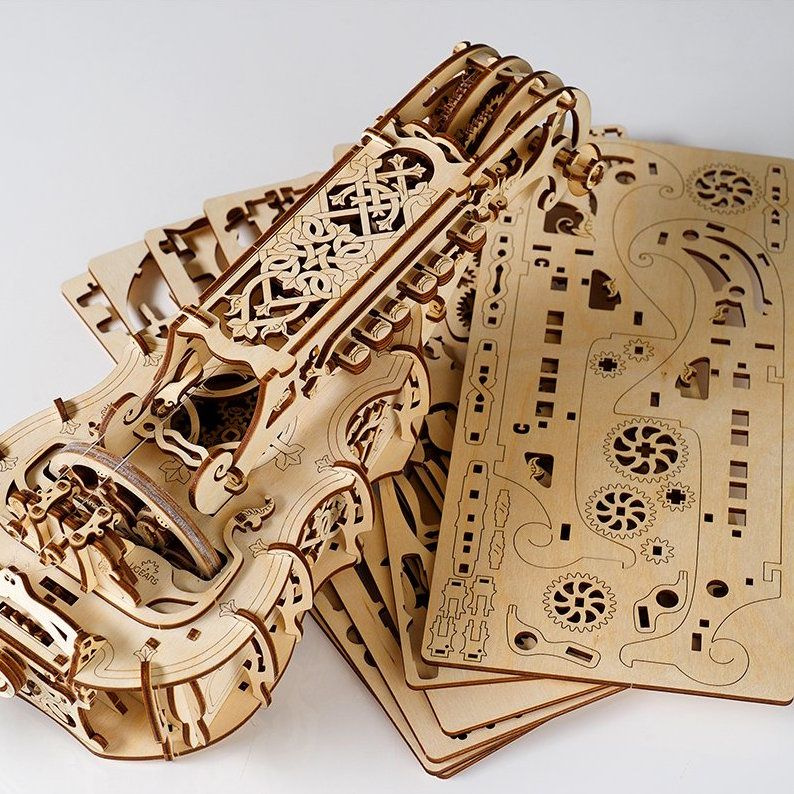
Features:
- 292 wooden pieces
- 45-page instruction booklet
- Includes everything you need to build your own hurdy-gurdy
It’s hurdy-gurdy season here in America. You can’t turn a corner without hearing the telltale sounds of the vielle à roue—the steady grind of the trompette, the buzz of the chien, the subtle clicks of the tangents. Ready to take the plunge and buy one for yourself? If so, you might consider UGears’ Hurdy-Gurdy Model Kit.
In all seriousness, I’m drawn to music that’s mercurial—to notes and textures that don’t find corollaries in my mental library of sounds. It’s that elusive sound, I think, that catches my attention, in everything from Neutral Milk Hotel to Ralph Stanley to the Shaggs.
I’m drawn to strange instruments—that’s why I started playing the banjo. I’d played guitar for years, but I always felt like I was strumming in someone’s shadow—playing a less competent version of something I’d already heard. When I played the simplest plucky phrase on a banjo, though, I only heard myself.
The hurdy-gurdy, too, was mysterious to me—it still is. I first heard a vielle à roue at an accordion festival, of all places—the Carrefour Mondial de l’Accordéon in Montmagny, Quebec. It was there that I discovered the traditional Québécois band Le Vent du Nord, whose songs often feature what I can best describe as a persistent, melodious buzz akin to a bagpipe.
When I first saw Le Vent du Nord perform—more than a decade ago, now—I remember searching the stage for the source of that tone. I couldn’t find it at first; it didn’t seem to be coming from the guitar, the fiddle, or the button box accordion. But then I noticed one of the musicians, Nicolas Boulerice, holding what looked to me like a thick, tapered wooden box. His left hand was wrapped over the top of it, and he seemed to be turning a handle with his right hand. What was the handle turning, though? I couldn’t see any strings, any frets, any indication of anything moving.
I soon learned that Boulerice’s instrument was called a “wheel fiddle”—a.k.a. a hurdy-gurdy.
The hurdy-gurdy dates back to the middle ages—it’s a descendent of the organistrum, which was played by two people—and it can be heard in music from a variety of European cultures. The hurdy-gurdy does indeed include a handle—a crank, it’s called—which turns a rosined wheel.
That wheel rubs against taut strings, some of which act as drones, others which convey melody when their tension is changed by the movement of wooden blocks, called tangents, that are attached to keys.
I was immediately fascinated by the hurdy-gurdy—both visually and aurally—but taken aback when I found out how expensive they are. Most start at $1000, and I already own my fair share of instruments that I can’t play very well. (Remember the accordion festival? In other news, would anyone like to buy an electric banjo?)
I’m not sure when or how I learned about the UGears Hurdy-Gurdy Model Kit, but I remember when it first occurred to me to buy one: in the late spring of 2020. My kids were six and eight, we were in the thick of quarantine, summer camp had just been canceled, and I was on the lookout for family-oriented activities. The three of us had already built a ukulele together, so this seemed like a natural next step. I showed them the picture of the kit to try and sell them on the idea. When in-person school returned, I suggested, they could brag to their friends that they built a quarantine hurdy-gurdy. What could be cooler?
But the notion that we’d build the kit together dissipated as soon as we opened the box and saw what was included: eight sheets of balsa-type wood suspending almost 300 pieces—many of them quite small—along with a 45-page instruction book. My son watched me punch a few wooden gears out of the wood and promptly started working on Legos; my daughter went back to drawing dragons. I couldn’t blame them; even I had my doubts that the project would pan out.
Over the days ahead, though, I made my way through the instructions. It wasn’t always fun—the wood is somewhat flimsy, and a few pieces splintered as I was freeing them from the sheet or snapping them into place. But after eight hours or so, I snapped together the keybox and you could suddenly see the instrument in its entirety. “Hey—look at that!” I said to my daughter, who was drawing dragons.
“Cool,” she said. “Does it make sound?”
“It might!” I offered.
And it does—sort of. UGears advertises the model as playable, but I’m inclined to agree with the online reviewers who say it’s more successful as a model. The tangents are tensioned with a single rubber band, the strings appear to be fishing line, and the crank on mine slips sometimes and threatens to snap altogether.
Even so, I’m glad I built it. It’s an ornate, unusual machine, and I’m pretty proud of the final product. In fact, it may turn out to be my gateway ‘gurdy. While I was building it, I joined a few hurdy-gurdy makers’ communities—the Nerdy Gurdy Builders, for example, and DigiGurdy Builders—on social media, and their postings of projects are making me think that it might be time to build a real hurdy-gurdy next. The world is opening up again, and in-person music festivals—including some that feature the hurdy-gurdy—are returning. My UGears hurdy-gurdy fits easily in a suitcase. Maybe I’ll go.




